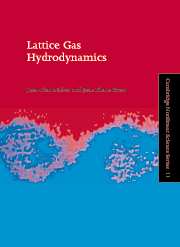Book contents
- Frontmatter
- Contents
- Preface
- Chapter 1 Basic ideas
- Chapter 2 Microdynamics: general formalism
- Chapter 3 Microdynamics: various examples
- Chapter 4 Equilibrium statistical mechanics
- Chapter 5 Macrodynamics: Chapman–Enskog method
- Chapter 6 Linearized hydrodynamics
- Chapter 7 Hydrodynamic fluctuations
- Chapter 8 Macrodynamics: projectors approach
- Chapter 9 Hydrodynamic regimes
- Chapter 10 Lattice gas simulations
- Chapter 11 Guide for further reading
- Appendix Mathematical details
- References
- Author index
- Subject index
Chapter 3 - Microdynamics: various examples
Published online by Cambridge University Press: 13 October 2009
- Frontmatter
- Contents
- Preface
- Chapter 1 Basic ideas
- Chapter 2 Microdynamics: general formalism
- Chapter 3 Microdynamics: various examples
- Chapter 4 Equilibrium statistical mechanics
- Chapter 5 Macrodynamics: Chapman–Enskog method
- Chapter 6 Linearized hydrodynamics
- Chapter 7 Hydrodynamic fluctuations
- Chapter 8 Macrodynamics: projectors approach
- Chapter 9 Hydrodynamic regimes
- Chapter 10 Lattice gas simulations
- Chapter 11 Guide for further reading
- Appendix Mathematical details
- References
- Author index
- Subject index
Summary
We now illustrate the abstract microdynamic notions of Chapter 2, with a presentation of lattice gas models in terms of the microdynamic tools. The models are chosen to illustrate the various microdynamical concepts; further models will be considered briefly in Chapter 11.
We start with the simplest two-dimensional model based on the square lattice, the earliest lattice gas model (1973) labeled HPP according to the initials of the authors: Hardy, de Pazzis and Pomeau. Sections 3.2 to 3.4 are devoted to models constructed on the triangular lattice and based on the FHP model initially introduced by Frisch, Hasslacher and Pomeau (1986). A ‘colored’ version of the FHP model, developed as a two-components lattice gas is presented in Section 3.5. A slightly more complex model, also based on the triangular lattice, but with thermal properties (Grosfils, Boon and Lallemand, 1992) is described in Section 3.6. We then move to three-dimensional systems in Section 3.7, as we introduce the basic (pseudo-four-dimensional) lattice gas model of d'Humières, Lallemand and Frisch (1986).
Except for the HPP model, all the models presented in this chapter, have been designed to exhibit large-scale dynamics in accordance with the Newtonian viscous behavior of isotropic fluids.
The HPP model
Historically, the first lattice gas model was introduced in the early seventies by Hardy, de Pazzis and Pomeau (1973) with motivations focusing on fundamental aspects of statistical physics (see also Hardy et al., 1972, 1976 and 1977).
- Type
- Chapter
- Information
- Lattice Gas Hydrodynamics , pp. 34 - 67Publisher: Cambridge University PressPrint publication year: 2001



